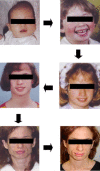Barraquer-Simons syndrome: a rare form of acquired lipodystrophy
- PMID: 26987365
- PMCID: PMC4797229
- DOI: 10.1186/s13104-016-1975-9
Barraquer-Simons syndrome: a rare form of acquired lipodystrophy
Abstract
Background: Human lipodystrophies are uncommon disorders, with important clinical consequences, which are often undiagnosed. The Barraquer-Simons syndrome is a form of partial symmetric lipodystrophy of unknown etiology, characterized by the loss of subcutaneous adipose tissue, limited to upper part of the body. Insulin resistance and metabolic complications are less common than with other lipodystrophy subtypes. Patients usually have decreased serum complement-component 3 levels, associated with complement activation by the alternative pathway, which may indicate the presence of renal involvement.
Case presentation: The authors report a case of a 31-year-old woman with progressive loss of subcutaneous fat, limited to the face, neck and thorax. She presented no severe metabolic complications, neither signs of insulin resistance. Laboratory tests revealed mild dyslipidemia, and low serum levels of complement-component 3. Clinical and biochemical characteristics were consistent with the diagnosis of Barraquer-Simons syndrome.
Conclusion: The present case illustrates the importance of recognizing the clinical features of this lipodystrophic syndrome, which may present potentially severe consequences and psychological distress. A brief overview is made, addressing the clinical signs of the disease, its course, and how to manage it.
Keywords: Acquired partial lipodystrophy; Adipose tissue; Barraquer–Simons syndrome; Cephalothoracic lipodystrophy; Hypocomplementemia.
Figures
References
Publication types
MeSH terms
Supplementary concepts
LinkOut - more resources
Full Text Sources
Other Literature Sources



